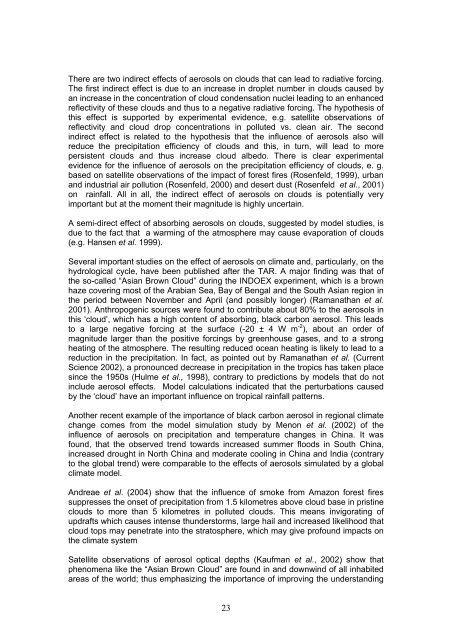Climate Change and the European Water Dimension - Agri ...
Climate Change and the European Water Dimension - Agri ...
Climate Change and the European Water Dimension - Agri ...
Create successful ePaper yourself
Turn your PDF publications into a flip-book with our unique Google optimized e-Paper software.
There are two indirect effects of aerosols on clouds that can lead to radiative forcing.<br />
The first indirect effect is due to an increase in droplet number in clouds caused by<br />
an increase in <strong>the</strong> concentration of cloud condensation nuclei leading to an enhanced<br />
reflectivity of <strong>the</strong>se clouds <strong>and</strong> thus to a negative radiative forcing. The hypo<strong>the</strong>sis of<br />
this effect is supported by experimental evidence, e.g. satellite observations of<br />
reflectivity <strong>and</strong> cloud drop concentrations in polluted vs. clean air. The second<br />
indirect effect is related to <strong>the</strong> hypo<strong>the</strong>sis that <strong>the</strong> influence of aerosols also will<br />
reduce <strong>the</strong> precipitation efficiency of clouds <strong>and</strong> this, in turn, will lead to more<br />
persistent clouds <strong>and</strong> thus increase cloud albedo. There is clear experimental<br />
evidence for <strong>the</strong> influence of aerosols on <strong>the</strong> precipitation efficiency of clouds, e. g.<br />
based on satellite observations of <strong>the</strong> impact of forest fires (Rosenfeld, 1999), urban<br />
<strong>and</strong> industrial air pollution (Rosenfeld, 2000) <strong>and</strong> desert dust (Rosenfeld et al., 2001)<br />
on rainfall. All in all, <strong>the</strong> indirect effect of aerosols on clouds is potentially very<br />
important but at <strong>the</strong> moment <strong>the</strong>ir magnitude is highly uncertain.<br />
A semi-direct effect of absorbing aerosols on clouds, suggested by model studies, is<br />
due to <strong>the</strong> fact that a warming of <strong>the</strong> atmosphere may cause evaporation of clouds<br />
(e.g. Hansen et al. 1999).<br />
Several important studies on <strong>the</strong> effect of aerosols on climate <strong>and</strong>, particularly, on <strong>the</strong><br />
hydrological cycle, have been published after <strong>the</strong> TAR. A major finding was that of<br />
<strong>the</strong> so-called “Asian Brown Cloud” during <strong>the</strong> INDOEX experiment, which is a brown<br />
haze covering most of <strong>the</strong> Arabian Sea, Bay of Bengal <strong>and</strong> <strong>the</strong> South Asian region in<br />
<strong>the</strong> period between November <strong>and</strong> April (<strong>and</strong> possibly longer) (Ramanathan et al.<br />
2001). Anthropogenic sources were found to contribute about 80% to <strong>the</strong> aerosols in<br />
this ‘cloud’, which has a high content of absorbing, black carbon aerosol. This leads<br />
to a large negative forcing at <strong>the</strong> surface (-20 ± 4 W m -2 ), about an order of<br />
magnitude larger than <strong>the</strong> positive forcings by greenhouse gases, <strong>and</strong> to a strong<br />
heating of <strong>the</strong> atmosphere. The resulting reduced ocean heating is likely to lead to a<br />
reduction in <strong>the</strong> precipitation. In fact, as pointed out by Ramanathan et al. (Current<br />
Science 2002), a pronounced decrease in precipitation in <strong>the</strong> tropics has taken place<br />
since <strong>the</strong> 1950s (Hulme et al., 1998), contrary to predictions by models that do not<br />
include aerosol effects. Model calculations indicated that <strong>the</strong> perturbations caused<br />
by <strong>the</strong> ‘cloud’ have an important influence on tropical rainfall patterns.<br />
Ano<strong>the</strong>r recent example of <strong>the</strong> importance of black carbon aerosol in regional climate<br />
change comes from <strong>the</strong> model simulation study by Menon et al. (2002) of <strong>the</strong><br />
influence of aerosols on precipitation <strong>and</strong> temperature changes in China. It was<br />
found, that <strong>the</strong> observed trend towards increased summer floods in South China,<br />
increased drought in North China <strong>and</strong> moderate cooling in China <strong>and</strong> India (contrary<br />
to <strong>the</strong> global trend) were comparable to <strong>the</strong> effects of aerosols simulated by a global<br />
climate model.<br />
Andreae et al. (2004) show that <strong>the</strong> influence of smoke from Amazon forest fires<br />
suppresses <strong>the</strong> onset of precipitation from 1.5 kilometres above cloud base in pristine<br />
clouds to more than 5 kilometres in polluted clouds. This means invigorating of<br />
updrafts which causes intense thunderstorms, large hail <strong>and</strong> increased likelihood that<br />
cloud tops may penetrate into <strong>the</strong> stratosphere, which may give profound impacts on<br />
<strong>the</strong> climate system<br />
Satellite observations of aerosol optical depths (Kaufman et al., 2002) show that<br />
phenomena like <strong>the</strong> “Asian Brown Cloud” are found in <strong>and</strong> downwind of all inhabited<br />
areas of <strong>the</strong> world; thus emphasizing <strong>the</strong> importance of improving <strong>the</strong> underst<strong>and</strong>ing<br />
23













